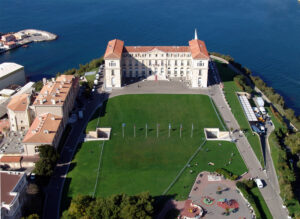The French National Program of « Physique et Chimie du Milieu Interstellaire » (PCMI) promotes research by astrophysicists, physicists, and chemists to make progress in the understanding of the circumstellar and interstellar medium in our Galaxy and in external galaxies. The next biennial conference of PCMI will take place in Marseille on June 25th – 29th, 2018 (https://pcmimarseille18.sciencescon…).

During this meeting, we will discuss recent advances in key PCMI science themes (we list below some of the topical issues that will be addressed during the meeting). The conference will also be the occasion to discuss the renewal of PCMI mandate : A dedicated session will be organised to foster discussions on the direction to follow during the next five years (from 2019 to 2023), in the context of the development of NOEMA, ALMA, JWST, and SOLEIL and of future instruments such as SKA, ATHENA, XFEL…
For the second time, in addition to the plenary sessions, there will be 4 discussion workshops dedicated to specific topics proposed by the PCMI community. These workshops aim to gather specialists and interested people to engage in active discussion of the proposed topic. The topics will be selected at the same time as the contributed talks.
We expect a large audience to discuss all the following questions and others.
* The interstellar medium (ISM) from the Milky Way to far external
galaxies :
We can first ask how giant molecular clouds (GMC) form and evolve : How to infer information about the matter distribution along the line of sight ? Are the ISM mass/density tracers such as CII, HI, CO, HCO+, HCN, quantitatively understood in the Milky Way ? How to take into account the stochastic nature of turbulence in ISM models ? What is the impact of anisotropic FUV field on the ISM structure and progresses of star formation ? What is the size distribution of dust in dense gas ? Are gas and dust well-coupled ? What is the typical lifetime of a GMC ? Are GMCs mostly isolated structures or accreting/loosing matter from/to their environment ? Are molecular cloud properties and star formation efficiencies affected by the galactic environment (e.g., arm/inter-arm, mergers) ? How do energetic phenomena (cosmic rays, SNs, …) affect the structure of the ISM ? Moreover, the study of molecular gas in galaxies near and far requires the use of indirect tracers of the molecular mass : What are the best molecular tracers of dense gas that can be detected in nearby galaxies ? What are the dust properties in nearby galaxies ? How does dust evolve in the ISM ? Can we build dust models parameterized as a function of the physical conditions (UV field, density) ? How different are the dust properties in nearby galaxies (LMC, SMC, M31, etc.) ? What does the detection of molecules tell us about the first galaxies ? What’s the impact of chemistry on the first generation of stars ?
* From molecular clouds to protoplanetary systems :
Many questions arise about the formation of stars and proto-planetary disks : Is the core mass function universal ? Are filament properties universal, and if so, why ? Are filaments sub-structured in fibers ? What’s the role of the magnetic field at different spatial scales is the ISM and different stages of the star formation process ? Does the kind of turbulence affect the star formation efficiency ? How does the grain size distribution vary in proto-planetary disks ? What traps dust in disks ? What are the properties of snow lines ? What is the limit of chemical complexity in disks ?
* On the origin of matter complexity :
Recent observations, and laboratory experiments have renewed long-standing issues : What are the most stable carbonaceous structures in space ? Are all DIBs associated with fullerenes ? Are branched alkyl molecules a first step towards aromatic cycles ? How does chirality appear ? What’s the relative importance of top-down and bottom-up chemistry on the global molecular budget ? Why are complex organic molecules (COMs) detected in unexpected environments (cold cores, PDRs, etc…) ? Why are COMs difficult to detect in comets ? What is the limit of molecular complexity in gas or ices ? Do we understand the link between isotopic ratios in the Solar System and in the local ISM ? What can we learn from pre-solar grains ? How representative are they of ISM dust ? How does dust form and evolve in circumstellar shells around evolved stars ? Can refractory dust be formed in the ISM ? In what forms are iron and sulfur incorporated into dust grains ? What explains the relative abundances of organic isomers ? How to trace the ortho/para ratio ? What needs to be measured first about state-to-state chemistry ? What are the key molecular compounds that need to be studied in space and laboratory to understand interstellar chemistry ? Can we realistically model surface chemistry ? Do molecular excited states play a role in the chemistry of PDRs ?
PCMI is an « action sur projet » from CNRS-INSU (Sciences de l’Univers), also supported by the CNRS-INP (Institute of Physics), the CNRS-INC (Institute of Chemistry), CNES (Centre National d’Études Spatiales), and CEA (Commissariat à l’énergie atomique et aux énergies alternatives).
Voir en ligne : https://pcmimarseille18.sciencesconf.org/
